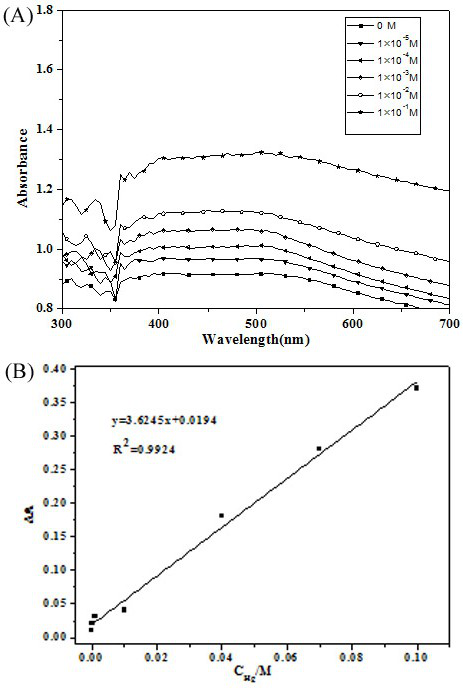A method for the colorimetric detection of organic mercury by amphiphilic polymer-modified AUNPS
An amphiphilic polymer, organic mercury technology, applied in the field of analytical chemistry science, can solve problems such as poor selectivity and inability to detect organic mercury, and achieve the effect of high detection specificity
- Summary
- Abstract
- Description
- Claims
- Application Information
AI Technical Summary
Problems solved by technology
Method used
Image
Examples
Embodiment 1
[0027] Example 1 Preparation of HPEI-D1-C16 / AuNPs
[0028] Weigh 30 mg amphiphilic hyperbranched polymer HPEI-D1-C16, dissolve it in 6 mL chloroform, mix and shake with 6 mL chloroauric acid aqueous solution, and after the system is separated, take the lower organic phase liquid and add 0.5 g Dried over magnesium sulfate, then centrifuged, reacted at 45 ℃ for 3 h, and prepared amphiphilic hyperbranched polymer HPEI-D1-C16 stably modified AuNPs colorimetric probe.
Embodiment 2
[0029] Example 2 Investigation of the sensitivity of HPEI-D1-C16 / AuNPs to the detection of organic mercury
[0030] In the present invention, amphiphilic hyperbranched polymer-stabilized AuNPs are used as colorimetric probes to detect the presence of organomercury. During the detection process, when organic mercury exists, the system can be observed from the original red to yellow by the naked eye, and the characteristic absorption peak of the ultraviolet absorption spectrum is red-shifted, thereby realizing the colorimetric detection of organic mercury.
[0031] Take 4.0 mL HPEI-D1-C16 / AuNPs chloroform solution, add 0.5 mL ethylmercury chloride solution of different concentrations and 3.5 mL water, shake for 2-5 min, remove the lower organic phase liquid, add 1.0 mL 1.0 ×10 -3 M sodium borohydride / methanol solution, finally dilute to 6 mL with methanol, after standing still for 2 min, take pictures and test its UV-Vis absorption spectrum ( figure 1 A).
[0032] Depend on ...
Embodiment 3
[0033] Example 3 Investigation of the selectivity of HPEI-D1-C16 / AuNPs for the detection of organic mercury
[0034] In the experiment of amphiphilic hyperbranched polymer stabilized AuNPs as a colorimetric probe for the detection of ethylmercury chloride, a variety of metal ions (Hg 2+ , Ag + , Mg 2+ , Ba 2+ ,Sr 2+ , Pb 2+ , Mn 2+ , Zn 2+ , Cs + , Ni 2+ , Cu 2+ , K + ) were used as interference ions to investigate the detection selectivity of the colorimetric probe. Take 4.0 mL of HPEI-D1-C16 / AuNPs in chloroform (13 parts), add 0.5 mL respectively to the concentration of 1.0×10 -5 M of ethylmercury chloride and 0.5 mL at a concentration of 1.0 × 10 -4 Hg of M 2 + , Ag + , Mg 2+ , Ba 2+ ,Sr 2+ , Pb 2+ , Mn 2+ , Zn 2+ , Cs + , Ni 2+ , Cu 2+ , K + solution, after shaking for 3 min, remove the lower organic phase liquid, add 1.0 mL 1.0×10 -3 M sodium borohydride / methanol solution, and finally dilute to 6 mL with methanol, after standing still for 2 min,...
PUM
 Login to View More
Login to View More Abstract
Description
Claims
Application Information
 Login to View More
Login to View More - R&D
- Intellectual Property
- Life Sciences
- Materials
- Tech Scout
- Unparalleled Data Quality
- Higher Quality Content
- 60% Fewer Hallucinations
Browse by: Latest US Patents, China's latest patents, Technical Efficacy Thesaurus, Application Domain, Technology Topic, Popular Technical Reports.
© 2025 PatSnap. All rights reserved.Legal|Privacy policy|Modern Slavery Act Transparency Statement|Sitemap|About US| Contact US: help@patsnap.com

